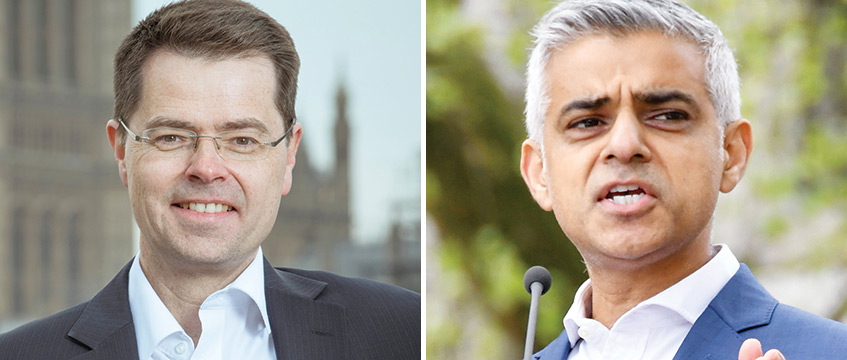Communities secretary James Brokenshire has attacked London mayor Sadiq Khan and the draft London Plan, questioning its housing targets and arguing that the plan is not consistent with the National Planning Policy Framework.
In a letter to Khan on 30 July, Brokenshire has threatened to intervene if the mayor fails to radically improve his London Plan, saying the increase in housing target (from 45,000 to 65,000 new homes a year) is “a helpful first step”, but doesn’t go far enough.
“I am not convinced your assessment of need reflects the full extent of housing need in London to tackle affordability problems,” he added.
Brokenshire also criticised a number of issues that are inconsistent with national policy and the NPPF, which was published last week. Those include allowing development on residential gardens and the GLA’s policies towards car parking.
Going further, Brokenshire said the London Plan was too detailed, complex and strayed beyond the strategic framework.
Brokenshire added: “I would remind you that I have powers to intervene before the plan is published, by giving a direction to avoid any inconsistencies with current national policy or to avoid detriment to the interests of an area outside of Greater London and I will be carefully considering whether it is appropriate to exercise any of my statutory powers.”
Hitting back, a spokesman for Khan said: “Rather than criticising the mayor’s ambitious plan and plucking numbers out of thin air, ministers should meet with him to discuss the powers and investment London urgently needs.
“With Sadiq as mayor, City Hall started building more genuinely affordable homes — including more social homes — last year than in any year since devolution, smashing the record under previous mayors.”
Squabbling won’t get houses built
There have been murmurings in the sector that government didn’t see eye to eye with City Hall over its draft London Plan since the plan was published. Those rumours have been proved true, with this punchy and pretty aggressive assault on the mayor of London, writes Paul Wellman, EG’s London residential analyst.
It is hard to look at this as anything other than pure politicking – but it does depend on which side of the fence you sit.
Brokenshire’s letter reiterated the well-known stats showing London’s severe housing pressures, with median house prices now more than 12 times median earnings, compared with the England-wide ratio of below eight times. The communities secretary said this is “far more than what an individual can typically expect to borrow for a mortgage, and clearly unacceptable”.
The NPPF, for the first time, has taken these measures of affordability into account, when objectively assessing need. This has ultimately placed higher housing targets in more affluent areas, which are typically Conservative-voting in nature. This is to be commended.
While more housing is obviously needed, and in the very long term should affect prices, higher targets and more completions don’t necessarily improve affordability.
The underlying affordability problems are more to do with a lack of land, a dearth of government subsidy (as a result of austerity), an over-reliance on private-led development and a change from social to “affordable housing”.
Khan instead pointed to the lack of funding. Last week he called on the government to devolve stamp duty receipts, to be invested in affordable homes.
Last year, stamp duty netted the government £13bn. The previous year, London accounted for 40% of the total SDLT revenue across the UK, according to Knight Frank, meaning devolution of the funds would have a significant impact on the mayor’s abilities to tackle the housing crisis. Realistically, though, the chances of the government agreeing are slim to none.
Government officials are said to believe London’s housing target should be as high as 100,000 a year. City Hall says this could be achieved only through loss of green belt, which flies in the face of Brokenshire’s comments that the London Plan needs amendments to “avoid detriment to the interests of an area outside of Greater London”.
Does this mean central government believes London can add 100,000 new homes within its current boundaries? As ever, something has to give, compromises are needed and difficult decisions need to be made. Kicking cans down the road and trying to dump responsibility on to the other tribe won’t work.
It’s an irony that one of the places that has contributed least to London’s housing delivery over many years is Bexley and Sidcup. You know who the MP for Old Bexley and Sidcup is, right? One James Brokenshire.
Main images: Geoff Pugh/REX/Shutterstock and Nils Jorgensen/REX/Shutterstock
To send feedback e-mail paul.wellman@egi.co.uk or tweet @paulwellman eg or @estatesgazette











